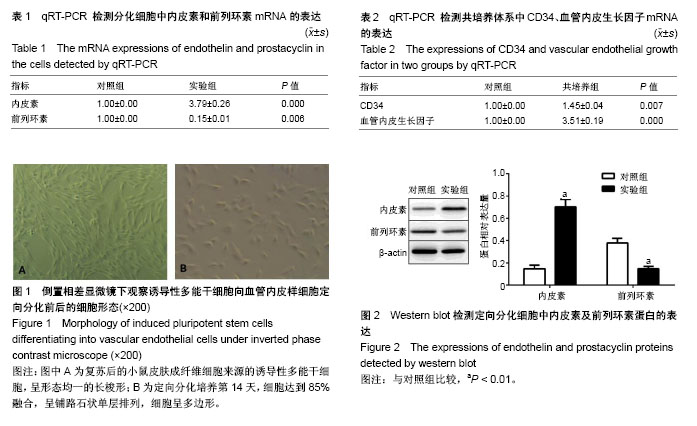中国组织工程研究 ›› 2018, Vol. 22 ›› Issue (21): 3371-3375.doi: 10.3969/j.issn.2095-4344.0902
• 干细胞培养与分化 stem cell culture and differentiation • 上一篇 下一篇
成纤维细胞来源诱导性多能干细胞定向分化为血管内皮样细胞及与牙髓干细胞的共培养
吕继忠
- 菏泽医学专科学校口腔教研室,山东省菏泽市 274000
Fibroblasts-derived induced pluripotent stem cells in pulp revascularization: differentiation into vascular endothelial cells and co-culture with dental pulp stem cells
Lü Ji-zhong
- Department of Stomatology, Heze Medical College, Heze 274000, Shandong Province, China
摘要:
文章快速阅读:
.jpg)
文题释义: 诱导性多能干细胞:是近年来通过将成体细胞重编程而获得的能分化成多种器官和组织细胞的多能干细胞,类似于胚胎干细胞和成体干细胞,但不涉及伦理问题,来源不受限制且更容易诱导定向分化,可以实现自体细胞移植,在再生医疗领域具有更广阔的应用前景。 恒牙牙髓血管再生:萌出时间较短的牙齿在形态结构上尚未发育完全被定义为年轻恒牙,创伤、龋病和畸形等因素均可导致牙髓感染、变性甚至坏死,严重影响恒牙牙根的正常发育成熟。牙髓血管再生术已经应用于临床治疗牙髓坏死,取得一定疗效。
摘要
背景:牙髓的血管重建是为组织工程牙髓再生提供养分与能量供给的重要环节。干细胞的选择和血管内皮样细胞的定向分化已经成为真正实现牙髓再生的重要研究方向。
目的:将小鼠成纤维细胞来源诱导性多能干细胞定向分化为血管内皮样细胞,探讨其与牙髓干细胞共培养促进血管新生的可行性。
方法:①采用酶消化法制备小鼠睾丸支持细胞饲养层;②外源添加血管内皮生长因子和碱性成纤维细胞生长因子诱导小鼠皮肤成纤维细胞来源诱导性多能干细胞定向分化为血管内皮样细胞并进行鉴定;③建立血管内皮样细胞与牙髓干细胞共培养体系,荧光实时定量PCR检测CD34、血管内皮生长因子mRNA的表达。
结果与结论:①诱导分化14 d后倒置显微镜下观察到细胞形态改变,呈现血管内皮形态;②流式细胞术鉴定诱导分化细胞CD31阳性,呈现内皮细胞表型;③诱导分化14 d后,培养液上清中内皮型一氧化氮合酶水平明显高于未分化细胞(P < 0.01);④诱导分化14 d后,与未分化对照组相比,实验组细胞内皮素表达增高(P < 0.01),前列环素表达降低(P < 0.01);⑤血管内皮样细胞与牙髓干细胞共培养5 d后,与血管内皮样细胞单独培养组相比,共培养组CD34和血管内皮生长因子表达增高(P < 0.01);⑥结果表明,小鼠成纤维细胞来源的诱导性多能干细胞可以定向分化为血管内皮样细胞,与牙髓干细胞共培养后有形成血管的倾向。
中国组织工程研究杂志出版内容重点:干细胞;骨髓干细胞;造血干细胞;脂肪干细胞;肿瘤干细胞;胚胎干细胞;脐带脐血干细胞;干细胞诱导;干细胞分化;组织工程
ORCID: 0000-0003-2767-2248(吕继忠)
中图分类号:

.jpg)
.jpg)